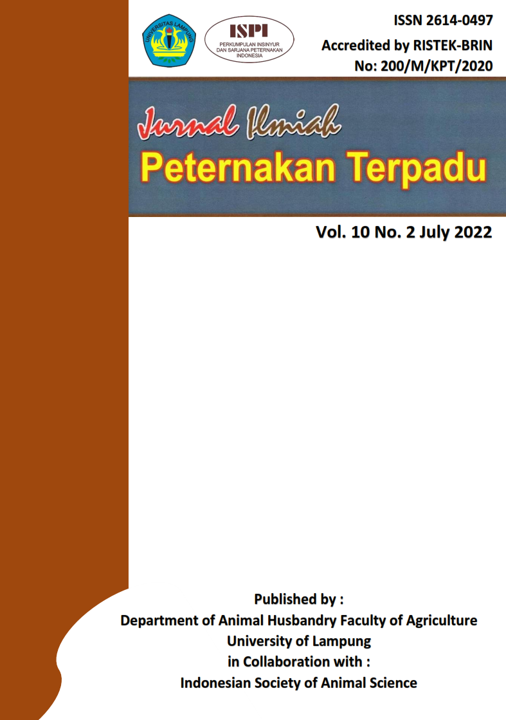Effectiveness of Cleaning Liquid on the Internal Quality of Chicken Egg During Storage
DOI:
https://doi.org/10.23960/jipt.v10i2.p175-192 Abstract View: 946
Abstract View: 946
Keywords:
Haugh unit, Albumen index, Yolk index, Storage duration, Cleaning liquidAbstract
This research aimed to determine the effect of cleaning liquid, storage duration, and the type of the best cleaning liquid and storage duration on the albumen index, yolk index, and haugh unit of chicken egg. This research was conducted from 21 January--10 February 2022 at the Livestock Production Laboratory, Department of Animal Husbandry, Faculty of Agriculture, University of Lampung. This research was conducted using a completely randomized design with a nested pattern with cleaning liquid (control, water, warm water, and alcohol 70%) as the main plot and long storage (7, 14, and 21 days) as subplots. Each treatment was repeated 3 times and each replication used 3 eggs, so that the total eggs used were 108 eggs with average egg weight of 59,71±6,33 and coefficient of diversity of 4,58%. The observed variables included albumen index, yolk index, and haugh unit (HU). The research data were analyzed with analysis of variance at the 5% level, if significantly different, continued with the BNT test. The results of the albumen index, yolk index, and haugh unit showed that the cleaning liquid treatment had no significant effect (P>0,05), while the storage duration treatment had a significant effect (P<0,05). Storage duration of 7 days can maintain albumen index, yolk index, and haugh unit from all treatments. The conclusion was the cleaning liquid and the best storage duration were alcohol 70% and 7 days of storage.
Downloads
References
Abbas, M.H. 1989. Pengelolaan Produksi Unggas. Jilid Pertama. Universitas Andalas. Sumatera Barat.
Astuti, D.P.P., A.T.N. Krisnaningsih. 2011. Dasar Teknologi Hasil Ternak. Fakultas Peternakan. Universitas Kanjuruhan Malang.
Budiman, C., Rukmiasih. 2007. Karateristik putih telur itik Tegal. Fakultas Peternakan. Institut Pertanian Bogor. Bogor.
Elisa. 2016. Komposisi dan Kualitas Telur. Universitas Gadjah Mada. Yogyakarta.
Fibrianti, S.M., I.K. Suada, M.D. Rudyanto. 2012. Kualitas telur ayam konsumsi yang dibersihkan dan tanpa dibersihkan selama penyimpanan suhu kamar. Indonesia Medicus Veterinus, 1(3): 408– 416.
Haryanto. 2010. Membuat Telur Asin. Kanisius. Yogyakarta.
Heath, J.I. 1977. Chemical and related osmotic changes in egg albumen during storage. Poult. Sci. 56: 822-828.
Hiroko, S.P., T. Kurtini, Riyanti. 2014. Pengaruh lama simpan dan warna kerabang telur ayam ras terhadap indeks albumen, indeks yolk, dan pH telur. Jurnal Ilmiah Peternakan Terpadu, 2(3): 108-114. DOI: 10.23960/jipt.v2i3.p%25p
Hutchison, M.L., J. Gittins, A.W. Sparks, T.J. Humphrey, C. Burton, A. Moore. 2004. An assessment of the microbiological risks involved with egg washing under commercial conditions. J. Food Prot. 67:4–11
Indratiningsih. 1984. Pengaruh Flesh Head pada Telur Ayam Kosumsi selama Penyimpanan. Universitas Gadjah Mada. Yogyakarta
Koswara, S. 2009. Teknologi Pengolahan Telur. eBookPangan.com. Diakses pada 10 Februari 2022.
Kurtini, T., K. Nova, D. Septinova. 2011. Produksi Ternak Unggas. Universitas Lampung. Bandar Lampung.
Kunsah, B. 2016. Analisa Kadar Protein Telur Ayam Kampung (Gallus domesticus) Terhadap Lama Penyimpanan Pada Suhu 12 – 15°C. Laporan Penelitian. Universitas Muhammadiyah Surabaya. Surabaya.
Leu, S., W. Mesens, K.D. Reu, S.D. Preter, L. Herman, M. Heyndrickx, J.D. Baerdemaeker, C.W. Michiels, M. Bain. 2011. Effect of egg washing on the cuticle quality of brown and white table eggs. Journal of Food Protection. 74(10): 1649–1654.
Margono, T., D. Suryati, S. Hartinah. 2000. Buku Panduan Teknologi Pangan. Pusat Informasi Wanita dalam Pembangunan PDII-LIPI Bekerjasama dengan Swiss Development Cooperation. Jakarta Press. Jakarta.
Messens, W., J. Gittins, S. Leleu, N. Sparks. 2011. Egg decontamination by egg washing, In Y. Nys, M. Bain, and F. Van Immerseel (ed.), Improving the safety and quality of eggs and egg products. Woodhead Publishing Limited. Cambridge. UK. p. 163–180.
Miranda, J.M., X. Anton, C. Redondo-Valbuena. 2015. Egg and egg derived foods: effet on human health and use as functional foods. Nutrinet, 7(1):706-729
Mountney, G. I. 1976. Poultry Technology. 2nd Edition. The AVI Publishing Inc. Westport.
Panda, P. 1996. Textbook of Egg and Poultry Technology. Ram Printograph. India.
Park, Y.S., I.J. Yoo, K.H. Jeon, H.K. Kim, E.J. Chang, H.I. Oh. 2003. Effects of various eggshell treatments on the egg quality during storage. Asian-Australasian Journal of Animal Sciences, 16(8): 1224-1229. DOI: 10.5713/ajas.2003.1224
Pescatore, T., J. Jacob. 2011. Grading Table Eggs. University of' Kentucky. Cooperative Extension. Lexington.
Sastrawan, I.M.A., I.B.N. Swacita, I.M. Sukada. 2013. Bahan pembersih kulit telur meningkatkan kualitas telur ayam yang disimpan pada suhu kamar. Indonesia Medicus Veterinus, 2(2): 132 – 141.
Khan, J.A., R. Sharma. 2012. Assessment of antibacterial propertis of the ferns Nephrolepis thuberosa. International Journal of Biology, Pharmacy and Alied Sciences, 1(10): 1524-1529.
Soepardi. 1981. Proses Pengawetan Telur Ayam Konsumsi. Majalah Poultry Indonesia. Hal 15.
Soeparno, R. A. Rihastuti, Indratiningsih, S. Triatmojo. 2011. Dasar Teknologi Hasil Ternak. Fakultas Peternakan. Universitas Gadjah Mada. UGM Press. Yogyakarta.
Standar Nasional Indonesia. 2008. Telur Ayam Konsumsi. 3926:2008. Jakarta.
Sudaryani, T. 2009. Kualitas Telur. Penebar Swadaya. Jakarta.
United States Departement of Agriculture (USDA). 2011. Choice Reviews Online. 48(07): 3848-3859
Yuwanta. 2010. Telur dan Kualitas Telur. Fakultas Peternakan. Universitas Gadjah Mada.Yogyakarta
Downloads
Published
How to Cite
Issue
Section
License

Jurnal Ilmiah Peternakan Terpadu(JIPT) is licensed under a Creative Commons Attribution 4.0 International License.
Authors who publish with this journal agree to the following terms:
- Authors retain copyright and grant the journal right of first publication with the work simultaneously licensed under a Creative Commons Attribution License that allows others to share the work with an acknowledgement of the work's authorship and initial publication in this journal.
- Authors are able to enter into separate, additional contractual arrangements for the non-exclusive distribution of the journal's published version of the work (e.g., post it to an institutional repository or publish it in a book), with an acknowledgement of its initial publication in this journal.
- Authors are permitted and encouraged to post their work online (e.g., in institutional repositories or on their website) prior to and during the submission process, as it can lead to productive exchanges, as well as earlier and greater citation of published work (See The Effect of Open Access).





















